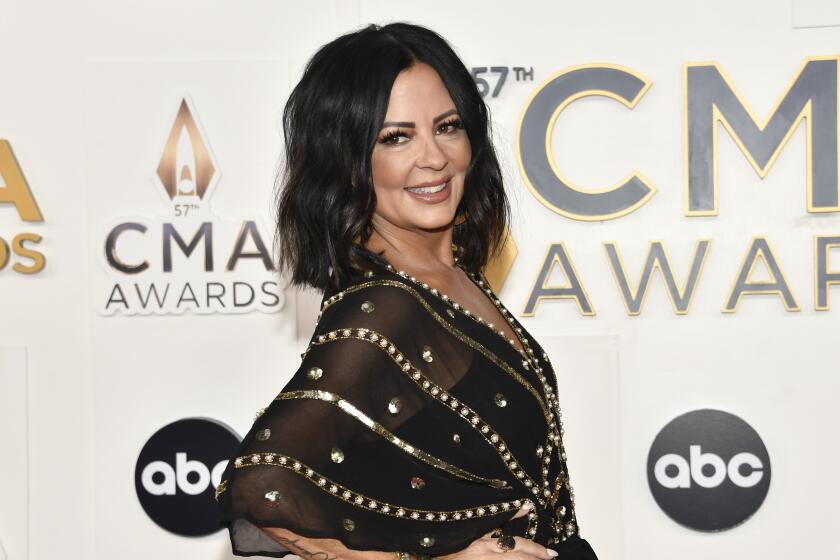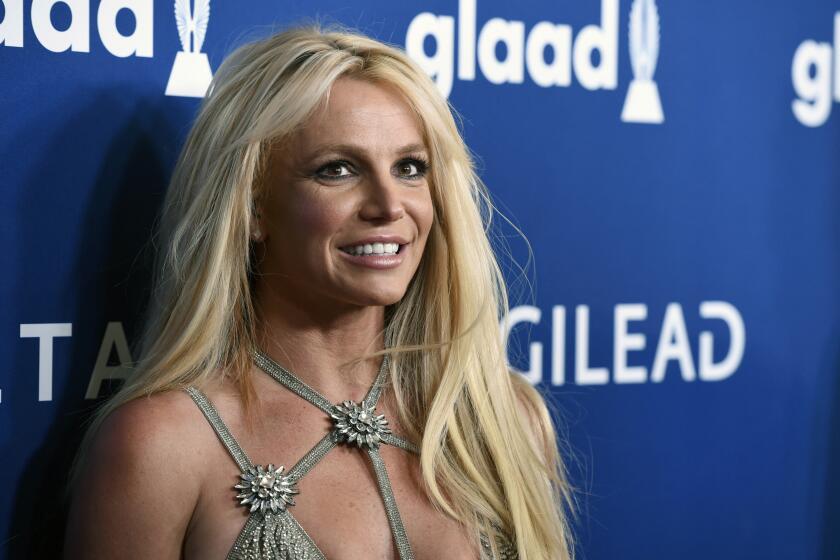From the King to Queen : Nashville’s new wave is as likely to draw inspiration from pop and rock heroes as from tradition, helping lead country to its greatest popularity ever
The following account of attending a Queen concert years ago as a teen-ager is something you’d expect from a longhaired hard-rocker.
“My ears are still ringing from the concert,” the reminiscence begins. “I was standin’ on my seat when (Queen’s) Brian May started playing this guitar solo . . . and I stood up with my fist high in the air, and I screamed so loud I could feel the veins in my neck.
“And I was feeling, ‘Bring me anything in this world that hasn’t been done by mankind. I want to take a crack at it right this second.’ And I was thinking, one day I’m going to feel this feeling--only it’s gonna be me up there on that stage.”
Instead, they are the words of country sensation Garth Brooks, who also cites such non-Nashville figures as James Taylor, Dan Fogelberg, Billy Joel and even KISS in a long line of influences.
Rival Clint Black, meanwhile, lists Jimmy Buffett, Bob Seger, Steely Dan and Little Feat alongside customary country heroes Merle Haggard and George Jones. Wynonna Judd talks at length about Aretha Franklin, Bonnie Raitt and U2--as well as Emmylou Harris and Patsy Cline.
All this talk about pop influences would have been heresy a decade ago in country music--back when pop was a dirty word among country music purists in Nashville, shorthand for sellout .
But it’s precisely the bold use of pop and rock influences by a new generation of artists and producers that has energized country music and pushed it to its greatest level of popularity ever.
Tony Brown, head of artists and repertoire for MCA Records Nashville, believes the key to what’s happening is the “honest connection” between today’s country artists and their pop-rock influences.
“Back in the days when pop was a dirty word here, you had country artists hearing something in a pop record that they thought would be commercial and then go into a recording session and say, ‘Copy this,’ ” says Brown, who signed Trisha Yearwood at MCA and produced the latest albums by Wynonna Judd and Vince Gill.
“Now when you talk about an artist like Wynonna or Trisha or Vince, you’re talking about people who not only grew up listening to the pop and rock artists but in many cases know the artists personally. There is mutual respect.
“Look at Don Henley singing on Trisha’s video (“Walkaway Joe”). You probably wouldn’t have seen that five years ago, because people would have thought she was selling out or maybe, even, they were both selling out. But now it makes sense. People accept it as a true, creative pairing. It’s a whole new ballgame.”
If Hank Williams and Patsy Cline remain quintessential influences in country music, any examination of the evolution of modern country invariably centers on Elvis Presley, the Eagles and Emmylou Harris.
Presley had a profound influence on country music. His 1955 recording of “I Forgot to Remember to Forget” spent 39 weeks on the country sales charts before “Heartbreak Hotel” introduced him to a pop audience, and he remained a fixture on the country charts for most of his career. This helped condition the country audience to accept blues and rock elements in their music. At the same time, Presley gave pop and rock fans a taste of country, injecting country elements in various hit singles, from “A Fool Such as I” to “Suspicious Minds,” and in countless album tracks.
But country’s influences in rock waned in the ‘60s as British bands, especially, turned more toward the music’s blues component.
Near the end of the decade, however, two landmark albums helped revive rock’s interest in country music: the Byrds’ “Sweetheart of the Rodeo” in 1968 and Bob Dylan’s “Nashville Skyline” in 1969.
One reason for the Byrds’ country swing was Gram Parsons, a Harvard dropout whose music was an inspiring blend of the sentimentality of country with the contemporary bite of rock.
After the Byrds, Parsons and Chris Hillman formed the Flying Burrito Brothers, a Los Angeles-based group that never caught on commercially but whose approach greatly influenced the Eagles, whose music was widely played on country radio stations. Parsons’ legacy also includes Emmylou Harris, who not only recorded with Parsons, but also picked up much of his artistic vision.
Both the Eagles, whose hits included such country-leaning numbers as “The Best of My Love” and “Lyin’ Eyes,” and Harris, whose records combined traditional country numbers with compositions by such non-country writers as Paul Simon and Lennon-McCartney, served as a blueprint for what is happening now in country.
“I think the Eagles in a very subtle fashion integrated some of the lyrical and stylistic values of country into rock, and in turn they made a very large audience comfortable with that musical vocabulary,” says Bill Ivey, of the Country Music Foundation in Nashville.
“They also influenced this generation of country singers. I haven’t heard them say it, but I bet that half of the sort of Highway 101, Restless Heart-type bands would cite the Eagles as a major influence.”
Linda Ronstadt, an ally of the Eagles, also drew from rock and country sources.
But, Ivey and other country insiders say, Emmylou Harris’ stamp may even be greater on today’s new country stars. She’s even been called the “godmother of modern country music.”
Harris, who remains one of country’s most compelling talents, demonstrated the advantages of coming into a musical tradition from the outside.
Rather than growing up in the boundaries of country the way Tammy Wynette and Loretta Lynn did, Harris was a Nashville outsider when she recorded her landmark “Pieces of the Sky” album in 1975.
“I had a very eclectic spectrum of taste,” she says. “I loved folk, folk blues. Bob Dylan, for instance, was a huge influence on me, though my brother was a big country music fan so I heard Buck Owens and Bob Dylan in sort of the same day. But it was the country focus that Gram gave me that brought it all together. It was the missing piece to my puzzle.
“Gram gave me a deeper appreciation of country. I had a sort of intellectual appreciation of it before, but then all of a sudden my heart was affected. I could hear the soulfulness in it.
“I began to understand how you could put George Jones and Merle Haggard on the record player next to Ray Charles and Merle Haggard or Joan Baez or Robert Johnson or Tom Rush. I learned to look in a lot of places for good songs and good singers and not think they all fit in one (record bin) marked ‘country’ or ‘folk’ or ‘blues’ or ‘rock.’ ”
Harris’ debut album, which was recorded in Los Angeles rather than Nashville, was hailed equally by country and pop-rock critics--and Harris has never looked back. She now lives in Nashville, but her music continues to draw from various emotional and musical sources.
She became an influence onstage and an inspiration offstage--showing that the boundaries could be stretched without any loss of artistic integrity or country purity. Her band has been a virtual breeding ground for country talent: Alumni include Rodney Crowell, Ricky Skaggs and MCA’s Tony Brown.
Even her influence, however, couldn’t break down the resistance of many Nashville insiders in the ‘70s and ‘80s to pure country tradition. The future, they agreed, rested in softer pop elements.
“I just felt that country . . . real country . . . could be extraordinarily popular to an audience out there that didn’t hear it much, because I was out on the road playing for people who never considered themselves country fans,” Harris says.
“I remember when Ricky was in the band. I used to go around to record companies to try to get him signed, and I was told point blank that he was too country. How do you answer that? There was this feeling that country music will never be popular unless we trick people and take away all the rough edges. My point was it’s the rough edges that give the music its appeal.”
Harris, who guests on Yearwood’s new album, “Hearts in Armor,” is encouraged by today’s trend toward broadening country boundaries.
“I think it is definitely very good,” she says. “These people are definitely talented and they have the goods--and there are a lot of other artists out there, like Iris DeMent and Lucinda Williams, who are bringing a larger spectrum to country than what you hear on the radio.”
So where is country headed?
Bill Ivey acknowledges that there’s a danger in going too far pop.
“I think what is happening is a mixed blessing,” he says. “It’s healthy in the sense we have a crop of performers and songwriters whose influences come from many different directions. They are not caught up in the idea that country is a regional expression or some sort of ethnic expression. This helps make what is happening now in country creditable and accessible to a really wide audience.
“The downside is that a lot of the music’s core integrity over the years has come out of the Merle Haggard-Johnny Cash-Waylon Jennings sort of up-from-the-soil aspect of country--and some of that is being lost.”
On balance, however, he is positive.
“This new crop of artists--and it’s a pretty long list--is very articulate,” he says. “They tend to be sophisticated as people as well as sophisticated as singers--and they can go on television or get in a video and break down stereotypes about country music. They can show that it has changed . . . but that it hasn’t lost its heart.”
More to Read
The biggest entertainment stories
Get our big stories about Hollywood, film, television, music, arts, culture and more right in your inbox as soon as they publish.
You may occasionally receive promotional content from the Los Angeles Times.






